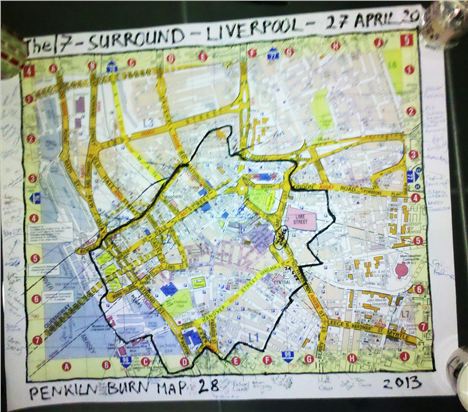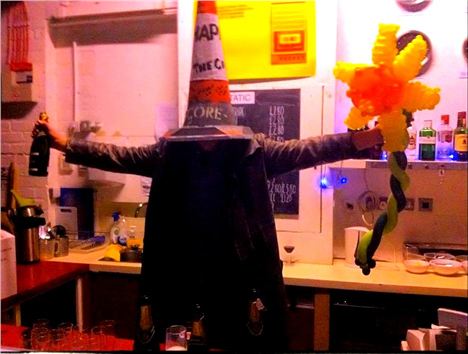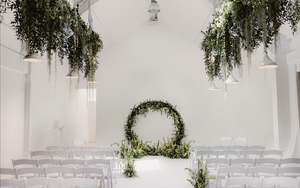BILL Drummond is almost impossible to categorise and, even if you try, he's likely to say he's the opposite.
His progress from Liverpool Art College to Science-Fiction Theatre, through punk, The Jams, K Foundation, Penkiln Burn and, latterly, globe-hopping situationism, has been well documented.
Drummond has become the proverbial grit in the oyster of life…somewhat irritating and uncomfortable to begin with, but through the ebb and flow of his successive waves of creative endeavour, produces unique pearls of individual statements and nonconformist self-expression
Yet there's only one person who can justify this journey and that's Drummond himself. But he won't and won’t explain why he won’t; not because he’s averse to categorisation or classification. What’s much more important for him is the act of being alive…of being in the moment and letting it construct its own synchronistic narrative, whether it be as the catalyst for public participation or the production of directives similar to public information posters to spread his messages
These include dozens of pamphlets and the occasional book (45, On the Shores of Lake Placid, 17 and 100 to name a few). No wonder Charles Shaar Murray called him a “cultural magician”. Perhaps shaman would be more appropriate.
So, back to his decision to return to Liverpool over April 27-28. Essentially, it was to mark his rite-of-passage at the age of 60, but also, to draw a natural conclusion to his project The 17.
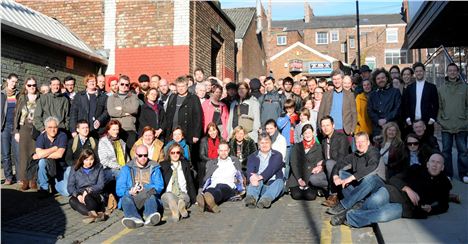 WAAY-OH to go: The final 17 outside Static Picture: Tracey Moberly
WAAY-OH to go: The final 17 outside Static Picture: Tracey Moberly
An online invitation went out to announce this and around 100 people showed up at the Static Gallery, in Roscoe Lane, to take part, including a couple who’d flown from Philadelphia especially.
Here’s what Drummond told them:
“What's happening here tonight is the performance which is end of the tour. A performance that you’re all involved in. It’s called 17. You're part of a choir. The choir existed in my imagination for most of my life.
“I did a deal with myself in around 2006 to take it out of my head of make his imaginary choir and make it a reality. I knew that I wanted to do the final performance in Liverpool when I turned 60 and, then, it would have a life of its own and do whatever it wanted to do. There would be no recordings or anything you could download or listen to by switching on the radio. The only way you could hear it was by being part of it. So, what we're going to do is to have a ring of people around the circumference of the city centre, starting off somewhere down Bold Street.
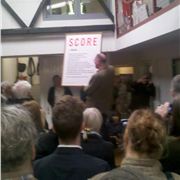 At Static“The first person would be dropped off and the next some fifty metres away within earshot. It’ll take around an hour to get it all sorted out.
At Static“The first person would be dropped off and the next some fifty metres away within earshot. It’ll take around an hour to get it all sorted out.
“Then, like links in a chain, the first one calls out to the second “Waay-Oh” and the second to the third until it gets back to the start. At first, I thought we could do it the once, but then really, we should do it five times since it’s the last performance and I thought well, yes, Liverpool people can cope with that.
“The real experience comes when you can hear the sound of someone calling in the distance as it comes closer to you. It’s an experience you’ll remember in 30 years time. It has that power."
So, that’s exactly what we did. Drummond had a map of the city centre and the newly-formed choir of 100 people followed him as we walked down to The Strand, past the Liver Buildings, up Tithebarn Street, down Renshaw Street and back to the Static. Every so often, one was dropped off with a handshake from Bill. I was left standing at the top of the bus shelters opposite St Johns Gardens.
After about half-an-hour, I heard the faint “WAAY-OH” calls in the distance which got closer and closer. The guy in front of me, by Dr Duncans, called out to me and, then, I called out at the top of my voice to the next-in-line. So it went on. One hundred participants and five Mexican “WAAY-OH” of sound circling the city
Drummond would appreciate the significance of the total. For me, the experience felt quite exhilarating given that the chain could so easily have been broken and, also, that we’d created this almost primeval communication in the middle of a cosmopolitan city. It was a memorable event.
Actually, “event” is a pale description of what took place. Much better to use the word “happening” used commonly in the 1960s.
Drummond had created this short-lived community to fulfil his original intentions of both NOTICE and SCORE. Somehow, it worked. It was a one-off and, given its transitory nature, made a personal and significant impact on everyone who took part.
Why? Simply because he’d persuaded us to create something that meant nothing and everything at the same time. Transitory in nature but permanent in memory.
Quixotic, yes, but historic and revelatory too.
Next day, Drummond fulfilled his desire to stand for 17 hours on the manhole cover in Mathew Street. Once again, it held huge personal significance for him. He’d originally set up as set-designer for Ken Campbell’s Science Fiction Theatre of Liverpool in the basement of the Liverpool School of Language, Music, Dream and Pun [now Flanagans]. That’s where he and Jayne Casey used to meet up prior to forming Big in Japan.
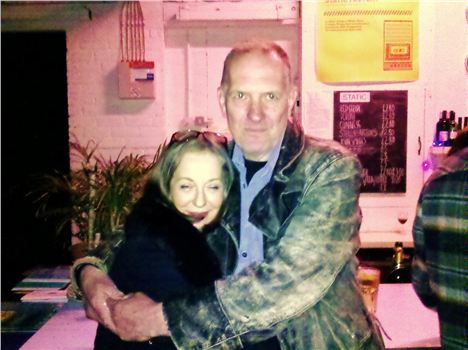 Big in Japan reunion for Jayne Casey And Bill Drummond
Big in Japan reunion for Jayne Casey And Bill Drummond
Just up the street was the original Eric’s – the cradle of Liverpool’s punk phenomenon. It was, I think, very appropriate. Bill was dressed for all contingencies. Just as well, really, since showers came down frequently. That didn’t dampen his spirits, though, as he continued to talk to passers-by and spent much time being filmed by a Swiss/German TV crew for a documentary.
As the day progressed towards evening, more and more people arrived, including party-goers attracted by the film-crew. At five to midnight, Bill produced a bucket of white paint and proceeded to paint over the 17 canvas which he’d carted around the world. An act of liberation, of renewal on a blank canvas.
Later, we made our way back to the Static Gallery to celebrate his birthday with champagne. He certainly likes to do things in style.
He gave a good speech and thanked everyone for being there with him, not just for the weekend but the longer journey over the last seven years or so. On leaving, later, a group of us decided to have one last “WAAY-OH”. We did. In the far distance, came the same response. Another significant moment and a perfect way to end the day.
What to make of it all? From a participants perspective, it certainly made magic out of the mundane. That’s the essence of situationism
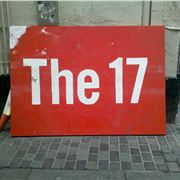 Final frame: The 17 canvasBill Drummond has spent the last few years refining this in order to create The 17 choir phenomenon as the antidote to all the manufactured sounds and celebrity-culture created by the contemporary music industry
Final frame: The 17 canvasBill Drummond has spent the last few years refining this in order to create The 17 choir phenomenon as the antidote to all the manufactured sounds and celebrity-culture created by the contemporary music industry
It’s his way of rejecting everything that’s gone before and starting at Year Zero. It’s both experimental and cathartic so, for him, it’s his way of going back-to-basics in a journey of self-discovery.
In doing so, Drummond has become the proverbial grit in the oyster of life…somewhat irritating and uncomfortable to begin with, but through the ebb and flow of his successive waves of creative endeavour, produces unique pearls of individual statements and nonconformist self-expression
Oh yes, and memorable events too. Great fun while they lasted.
17/17









